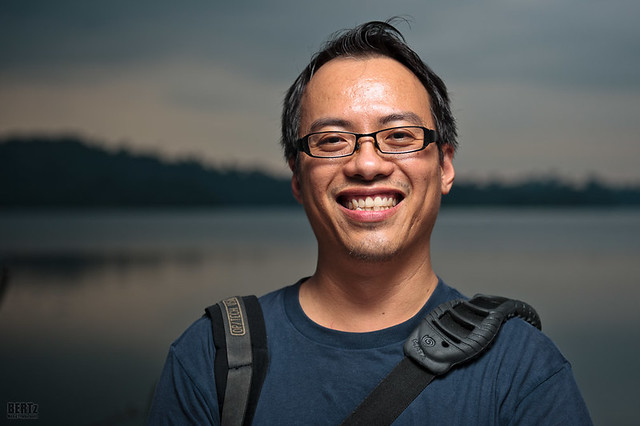Dear Thoongeng, i am using 40D + (17-55 F2.8) + (70-200 F4) + 2 nissin flash. I use the build in flash to trigger the 2 nissin flash. i wil usually place one di866 about 45 degrees to the back left of the subject. because di866 as 2 flashes (one main gun and one sub gun), i will put full power on the sub flash and aim it at the subject to create the hair light or rim light. Then the main gun of the di866 i will point at the ceiling. usually 1/32 is enough, no bounce card is used.
Then the other di622, i will place 45 degrees at the right front of the subject. di622 only have one main gun. i will make the main gun face the ceiling and this one will have a bounce card so subject will be nicely lighted up.
usually i will use Av mode: F4 + 135mm + 1/200 + iso<400 (i like the 70-200 F4. because at 135-200mm, it isolates the subject pretty good. i need 1/200 as kids move real fast. the kids know that they are being photographed and they know they are just to ignore me and do their own playing. iso<400 to have good quality photo ( i also notice that the lower the iso, the lesser sharpening artifacts from DPP software)
all these seems to good to be true. almost like a magic bullet. thats why i am scare whether there are any trade offs whch i dont see.....
Thanks for the detail you provided! I also use the Canon system and am reading up on it, but do not have a lot of experience with it so just offering what I know currently. Seniors can provide more information or point out my misunderstanding (hope not many) =p
For the Canon system the camera meters ambient and flash exposure separately. When using Av/Tv mode at exposure 0 (no exposure compensation), the metering is for what the camera thinks is the correct ambient exposure, the flash is ignored. When you dial in exposure compensation it affects how much ambient light is captured.
If you are using the E-TTL system, you control the flash exposure by dialing in Flash Exposure Compensation (FEC). However as you are using flash manually, the flash exposure is set manually by you.
However the situation is commonly complicated when there is spill of ambient to flash exposure, that's why sometimes you have to trial and error to set the ambient exposure (through exposure compensation) and flash exposure (through FEC) to get the correct overall exposure that you want. The common advice is to set the ambient correctly first, then play with FEC.
As you mentioned that your exposure is ok even with exposure compensation, it means in your indoor environment your flashes are able to expose your subject correctly without need for much ambient. So when lower ISO or use a faster shutter speed the only drawback that I can think of is that the exposure of areas not lit by flash will be more underexposed. Unless you have detail in these areas that you want to preserve, or else does not matter (as pointed out by tecnica)
And as suggested by the pro (catchlights =), if you use manual exposure, you have more 'exposure compensation' to play with (+/- 2 stops for 40D I believe). You can use the aperture priority mode to get a feel of the metering first then set the exposure, or if you're comfortable with the camera's metering bar then just use manual exposure straight away.
(as a side note as ambient and flash exposure are separate, you can use Aperture/Shutter priority mode in camera with manual flash exposure, also can do Manual mode with E-TTL flash exposure, or whatever combination

Hope this is useful and answers your question




